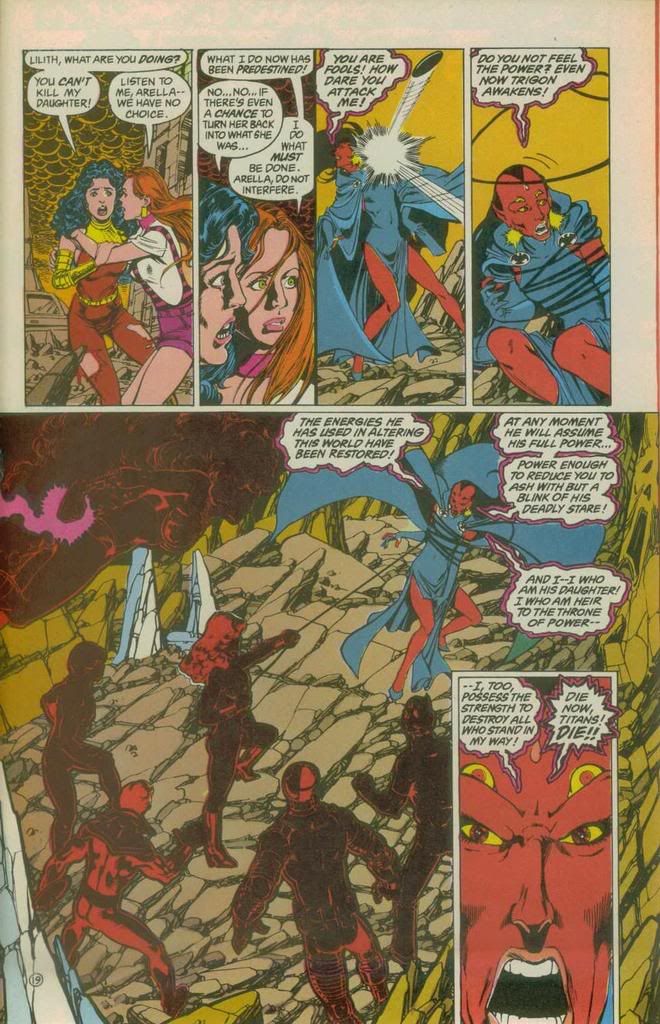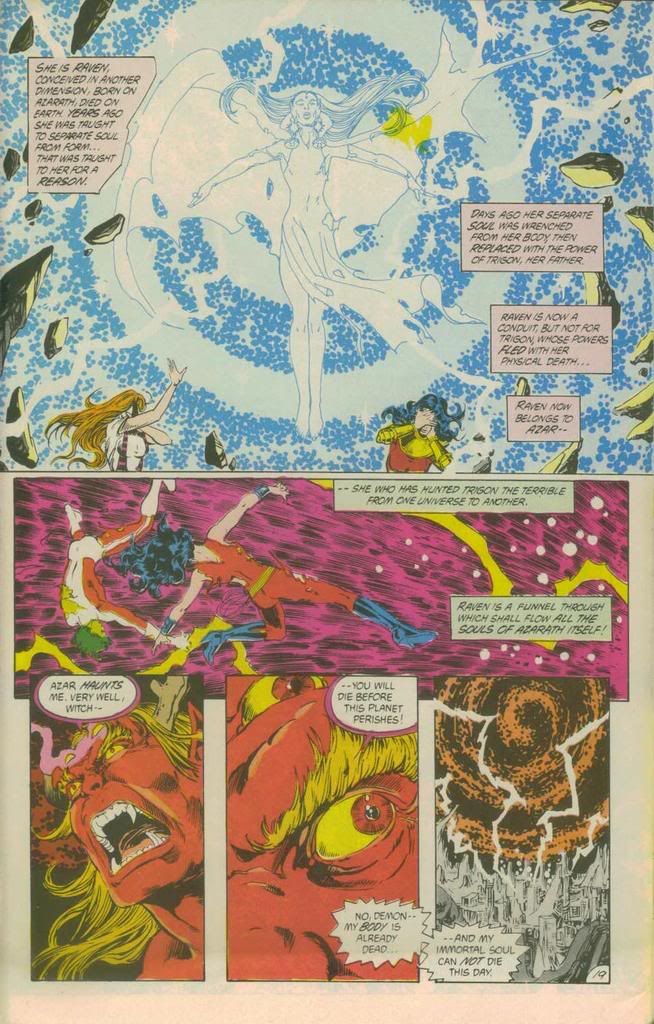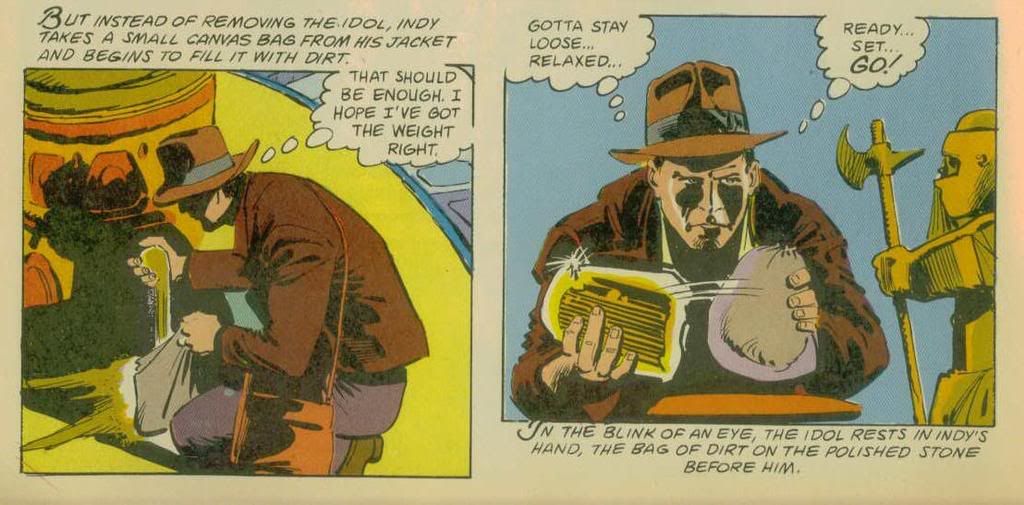Countdown To Adventure #8's lead story (written by Adam Beechen, pencilled by Allan Goldman, inked by Julio Ferreira) concludes about how you'd expect, but it's still fun to see Ellen Baker team up with Adam Strange. On its own it's a lot of fighting and shooting and heroic poses, and overall the arc has been pretty good. I can't say the same for the Forerunner story (written by Justin Gray, drawn by Fabrizio Fiorentino and Adam DeKraker), which might make more sense if I ever decide to revisit it, but which does end on a somewhat unexpected note. The story and art have improved over the past few months, but I didn't have much interest in Forerunner before, and I don't appear to now.
Teen Titans #57 (written by Sean McKeever, pencilled by Eddy Barrows, inked by Jimmy Palmiotti and Ruy Jose) continues the "Terror Titans" arc. This issue focuses on Ravager's fight against a couple of Terror Titans, juxtaposed against Robin's attempts at making up with Wonder Girl. I liked the issue pretty well. I thought it was paced well, I liked Barrows' storytelling, I think Palmiotti and Jose improve on his pencils, and I liked how Ravager was written. So, good job, all; and see you next month!
Green Lantern #29 (written by Geoff Johns, pencilled by Ivan Reis, inked by Oclair Albert) begins "Secret Origin," yet another look at Hal Jordan's life. Apparently Hal did just about anything he wanted to from a very early age. The End. Oh, okay, this issue goes into Hal's combative relationships with his mother and brothers, which in turn are based in his hero-worship of his dad, who you'll remember crashed his jet as young Hal watched. If you've been following Johns' work on the character, there won't be too many surprises here, except maybe for the details about his mom. As for the art, I found myself wondering if maybe Reis and Albert might have stepped aside for the flashback scenes. They're quite good on the regular sci-fi superhero material, but somehow their work felt a little too meticulous for this kind of coming-of-age story.
For some reason that I only noticed with this issue, Jim Gordon looks like Captain Kangaroo (with glasses) all throughout Batman Confidential #15 (written by Tony Bedard, pencilled by Rags Morales, inked by Mark Farmer). It's Part 3 of "Wrath Child," in which we learn the origin of the original Wrath and the startling secret of the current one. I like this story because it's high-concept: a supervillain who's the evil duplicate of Batman, fighting Batman and the newly-emancipated Nightwing. It provides a few fun touches: a flashback reveals a '60s-TV-show-style Batcopter and Batboat, and at one point Dick slams fist into palm a la Burt Ward, exclaiming "Holy--!" to boot. Morales' and Farmer's work is dynamic and clean, and I note approvingly that Morales draws this Nightwing to look appropriately younger than the Nightwing he currently draws in the eponymous book. Looking forward to the end of this one, but wishing this team would do more of the same.
The Spirit #15 (written by Sergio Aragones and Mark Evanier, drawn by Paul Smith) presents a diamond-smuggling switcheroo farce. It wants to be witty and nimble, but sadly comes up short. Although Paul Smith is an able cartoonist who apes Eisner's character designs well, he doesn't go in for the storytelling or layout flourishes that helped distinguish Darwyn Cooke's work. As for the story, Aragones and Evanier are normally very witty on Groo, but many of the gags here seem forced and/or familiar.
The mostly-prose Star Trek spinoff, New Frontier, gets another comic-book story with the new miniseries "Turnaround" (issue #1 written by Peter David and drawn by Stephen Thompson). I haven't read a New Frontier story in a few years, and it looks from this issue that there have been some changes to the cast. Of course, that assumes you're familiar with the cast in the first place. Otherwise, the story doesn't do much to introduce the players. Essentially, an experimental starship goes missing, Captain Calhoun and the USS Excalibur investigate, there's unrelated political intrigue featuring an ex-officer, and another ex-officer is now one of Trek's ubiquitous omnipotent beings. Oh, and there's another familiar-looking person on Excalibur who can pop in, EMH-like, when the story requires. The art is decent enough -- everything and everyone look appropriately Trek-y, and there aren't too many likenesses to worry about. It's not the worst Trek comic art I've seen, but not the best either. I will admit to being intrigued enough by the setup to come back for issue #2, but part of that is the hope that various subplots will start to knit together.
Finally, All-Star Superman #10 (written by Grant Morrison, drawn by Frank Quitely) is a poignant look at the last days of Superman ... at least on his particular Earth. I'm sure you've read about the synchronicity of this issue's conclusion with the Siegel heirs' legal victory, but even before I learned about that I was struck by Morrison's ability to evoke Superman. Morrison and Quitely use the image of Superman's literary creation as a touchstone for the character as ideal, which is a little ironic considering that they're working on an "ideal" version of the character.
But it's only an ideal from our perspective, isn't it? We're used to Superman as a commodity -- as copyright maintenance, as trademark material. We see Superman used as a sales-goosing guest star, as the center of a mythology that expands or contracts with the times, as a paragon of virtue challenged endlessly by fans who want something darker and more realistic.
All-Star Superman #10 speaks instead to "Superman's" power to lead by example. It's about inspiration, creation, and imitation in an endless cycle ("neverending," per the story's title). The hero of this story may be dying, but his legacy lives; just as the hero created by Jerry Siegel and Joe Shuster all those years ago has produced a body of work full of its own entertainment and inspiration. I don't mean to evangelize in such a purple way, and the image of a dying Superman is certainly not the hardest way to create sympathy in a reader -- but this issue pulls together the thematic threads of the series so well, and sets up its climax so effectively.
Morrison and Quitely's Superman speaks in simple, declarative sentences. He wears a costume which looks homemade, but not undignified. He's the center of his world, and this issue shows him preparing that world for his departure. Whether the series will actually end with his death seems immaterial at this point.












